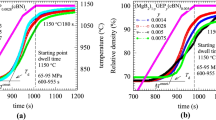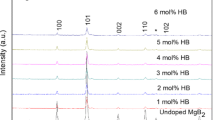Abstract
Additives to MgB2 can improve the superconducting functional characteristics, such as critical current density (J c) and irreversibility field (H irr). Recently, we have shown that repagermanium (C6H10Ge2O7) is an effective additive, enhancing both J c and H irr. To look into details of the processes taking place during the reactive sintering, a thermal analysis study (0.167 K s−1, in Ar) is reported. We used differential scanning calorimetry between 298 and 863 K and simultaneous thermogravimetric—differential thermal analysis between 298 and 1233 K. Samples were mixtures of powders with composition 97 mol% MgB2 and 3 mol% C6H10Ge2O7. Up to 863 K, repagermanium decomposes by multiple steps and forms amorphous phases. A reaction with MgB2 is not observed. Above this temperature, partial decomposition of MgB2 occurs. Crystalline Ge and MgO are detected before formation of Mg2Ge and MgB4, when temperature approaches the melting point of Ge (1211 K). Carbon substitution for boron in the crystal lattice of MgB2 is observed for samples heated above 863 K. The amount of substitutional C does not significantly change with temperature.






Similar content being viewed by others
References
Nagamatsu J, Nakagawa N, Muranaka T, Zenitani Y, Akimitsu J. Superconductivity at 39 K in magnesium diboride. Nature. 2001;410:63–4.
Batalu D, Aldica G, Burdusel M, Badica P. Short review on rare earth and metalloid oxide additions to MgB2 as a candidate superconducting material for medical applications. Key Eng Mater. 2015;638:357–62.
Cimberle MR, Novak M, Manfrinetti P, Palenzona A. Magnetic characterization of sintered MgB2 samples: effect of substitution or ‘doping’ with Li, Al and Si. Supercond Sci Technol. 2002;15:43–7.
Dou SX, Soltanian S, Horvat J, Wang XL, Zhou SH, Ionescu M, Liu HK, Munroe P, Tomsic M. Enhancement of the critical current density and flux pinning of MgB2 superconductor by nanoparticle SiC doping. Appl Phys Lett. 2002;81:3419–21.
Yeoh WK, Dou SX. Enhancement of Hc2 and Jc by carbon-based chemical doping. Phys C. 2007;456:170–9.
Batalu D, Aldica G, Popa S, Miu L, Enculescu M, Negrea RF, Pasuk I, Badica P. High magnetic field enhancement of the critical current density by Ge, GeO2 and Ge2C6H10O7 additions to MgB2. Scr Mater. 2014;82:61–4.
Batalu D, Aldica G, Burdusel M, Popa S, Enculescu M, Pasuk I, Miu D, Badica P. Ge-added MgB2 superconductor obtained by ex situ spark plasma sintering. J Supercond Nov Magn. 2015;28:531–4.
Batalu D, Aldica G, Popa S, Kuncser A, Mihalache V, Badica P. GeO2-added MgB2 superconductor obtained by spark plasma sintering. Sol State Sci. 2015;48:23–30.
Batalu D, Aldica G, Badica P. Ge2C6H10O7-added MgB2 superconductor obtained by ex situ spark plasma sintering. IEEE Trans Appl Supercond. 2016;26:7100104.
Ozturk O, Gokcen T, Cavdar S, Koralay H, Tasci AT. A study on nucleation, crystallization kinetics, microstructure and mechanical properties of Ru–Bi partial substituted BSCCO glass ceramics. J Therm Anal Calorim. 2016;123:1073–82.
Matskevich NI, Minenkov YF, Berezovskii GA. Calorimetric study and stability of Y2O2 phase in the Y–Ba–Cu–O system. J Therm Anal Calorim. 2015;121:771–6.
Kang DK, Kim DW, Choi SH, Kim CA, Ahn IS. Phase formation of MgB2 superconducting materials fabricated by spark plasma sintering. Metal Mater Int. 2009;15(1):15–9.
Yan SC, Yan G, Liu CF, Lu YF, Zhou L. Experimental study on the phase formation for the Mg–B system in Ar atmosphere. J Alloys Compd. 2007;437:298–301.
Ma ZQ, Liu YC. Low-temperature synthesis of MgB2 superconductors. Inter Mater Rev. 2011;56:267–86.
Lezza P, Gladyshevskii R, Suo HL, Flukiger R. Quantitative study of the inhomogeneous distribution of phases in Fe-sheathed ex situ MgB2 tapes. Supercond Sci Technol. 2005;18(5):753–7.
Tsutsui M, Kakimoto N, Axtell DD, Oikawa H, Asai K. Crystal-structure of carboxyethylgermanium sesquioxide. J Am Chem Soc. 1976;98(25):8287–9.
Kaplan BJ, Parish WW, Andrus GM, Simpson JSA, Field CJ. Germane facts about germanium sesquioxide: I. Chemistry and anticancer properties. J Altern Complem Med. 2004;10:337–44.
Jirasko R, Holcapek M, Rosenberg E. Characterization of bis-carboxyethyl germanium sesquioxide and its complexes with amino acids using electrospray QqTOF mass spectrometry. Inter J Mass Spectrom. 2009;280:198–203.
Shangguan GQ, Huang LL, Qu XG. The synthesis and cytotoxic activity of novel organogermanium sesquioxides with anthraquinone or naphthalene moiety. Chin Chem Lett. 2007;18:1347–50.
Shangguan G, Xing F, Qu X, Mao J, Zhao D, Zhao X, Ren J. DNA binding specificity and cytotoxicity of novel antitumor agent Ge132 derivatives. Bioorg Med Chem Lett. 2005;15:2962–5.
Pi J, Zeng J, Luo JJ, Yang PH, Cai JY. Synthesis and biological evaluation of germanium(IV)–polyphenol complexes as potential anti-cancer agents. Bioorg Med Chem Lett. 2013;23:2902–8.
Nakamura T, Nagura T, Akiba M, Sato K, Tokuji Y, Ohnishi M, Osada K. Promotive effects of the dietary organic germanium poly-trans-[(2-carboxyethyl) germasesquioxane] (Ge-132) on the secretion and antioxidative activity of bile rodents. J Health Sci. 2010;56:72–80.
Shimada Y, Sato K, Tokuji Y, Nakamura T. Nuclear magnetic resonance studies of the interactions between the organic germanium compound Ge-132 and saccharides. Carbohyd Sci. 2015;407:10–5.
Nakamura T, Saito M, Shimada Y, Fukaya H, Shida Y, Tokuji Y. Induction of aminolevulinic acid synthase gene expression and enhancement of metabolite, protoporphyrin IX, excretion by organic germanium. Eur J Pharmacol. 2011;653:75–81.
Batalu D, Paun A, Ferbinteanu M, Aldica G, Badica P. Thermal analysis of repagermanium. Themochim Acta. doi:10.1016/j.tca.2016.10.005.
Hu B, Du Y, Xu H, Sun W, Zhang WW, Zhao D. Thermodynamic description of the C-Ge and C-Mg systems. J Min Metall Sect B Metall. 2010;46:97–103.
Alarco JA, Chou A, Talbotab PC, Mackinno IDR. Phonon modes of MgB2: super-lattice structures and spectral response. Phys Chem Chem Phys. 2014;16:24443–56.
Galeener FL, Leadbetter AJ, Stringfellow MW. Comparison of the neutron, Raman, and infrared vibrational spectra of vitreous SiO2, GeO2, and BeF2. Phys Rev B. 1983;27:1052–78.
Rivillon S, Chabal YJ, Amy F, Kahn A. Hydrogen passivation of germanium (100) surface using wet chemical preparation. Appl Phys Lett. 2005;87:253101.
Salvi TBD, Job EA, Ribeiro JLS. New flexible and transparent solution-based germanium-sulfide polymeric materials. J Braz Chem Soc. 2015;26:992–1003.
Lee GE, Seto YJ, Hirao T, Bernath FP, LeRoy JR. FTIR emission spectra, molecular constants, and potential curve of ground state GeO. J Mol Spectr. 1999;194:197–202.
Hanna R. Infrared properties of magnesium oxide. J Am Ceram Soc. 1965;48(7):376–80.
Adebayo GA, Liang Y, Miranda CR, Scandolo S. Infrared absorption of MgO at high pressures and temperatures: a molecular dynamic study. J Chem Phys. 2009;131:014506.
Lott LA, Lynch DW. Infrared absorption in Mg2Ge. Phys Rev. 1966;141(2):681–6.
Nyquist RA, Kagel RO. Infrared Spectra of Inorganic Compounds (3800–45 cm−1), vol. 4. San Diego: Academic Press; 1971.
Gogotsi YG, Andrievski RA, editors. Material science of carbide, nitride and borides. Berlin: Kluwer Academic Publishers; 1999.
Brame EG Jr, Margrave JL, Meloche VW. Infra-red spectra of inorganic solids—II oxides, nitrides, carbides, and borides. J Inorg Nucl Chem. 1957;5(1):48–52.
Yang GR, Zhao YP, Tong BY. FTIR and uv study of amorphous silicon-boron alloys deposited by LPCVD. MRS Proc. 1996;426:83. doi:10.1557/PROC-426-83.
Paskevicius M, Pitt MP, Webb CJ, Sheppard DA, Filso U, Gray EM, Buckley CE. In-situ x-ray diffraction study of gamma-Mg(BH4)(2) decomposition. J Phys Chem C. 2012;116:15231–40.
Dou SX, Shcherbakova O, Yeoh WK, Kim JH, Soltanian S, Wang XL, Senatore C, Flukiger R, Dhalle M, Husnjak O, Babic E. Mechanism of enhancement in electromagnetic properties of MgB2 by nano SiC doping. Phys Rev Lett. 2007;98:097002.
Lee S, Masui T, Yamamoto A, Uchiyama H, Tajima S. Crystal growth of C-doped MgB2 superconductors: accidental doping and inhomogeneity. Phys C. 2004;412–414:31–5.
Frisch MJ, et al., editors. Gaussian 03, revision B.04. Pittsburgh: Gaussian, Inc.; 2003.
Acknowledgements
This work was performed within Partnership program in the priority domains—PN II, funded by MEN-UEFISCDI, project No. 214/2014 BENZISUPRA. Authors acknowledge Dr. V. Mihalache for XRD measurements and Dr. I. Pasuk for useful discussions.
Author information
Authors and Affiliations
Corresponding author
Rights and permissions
About this article
Cite this article
Aldica, G., Matei, C., Paun, A. et al. Thermal analysis on C6H10Ge2O7-doped MgB2 . J Therm Anal Calorim 127, 173–179 (2017). https://doi.org/10.1007/s10973-016-5877-9
Received:
Accepted:
Published:
Issue Date:
DOI: https://doi.org/10.1007/s10973-016-5877-9




